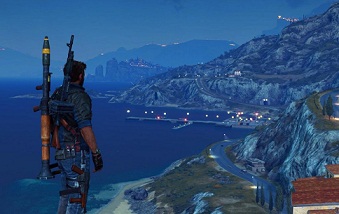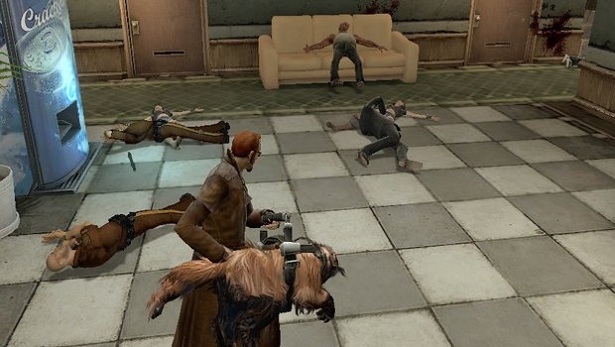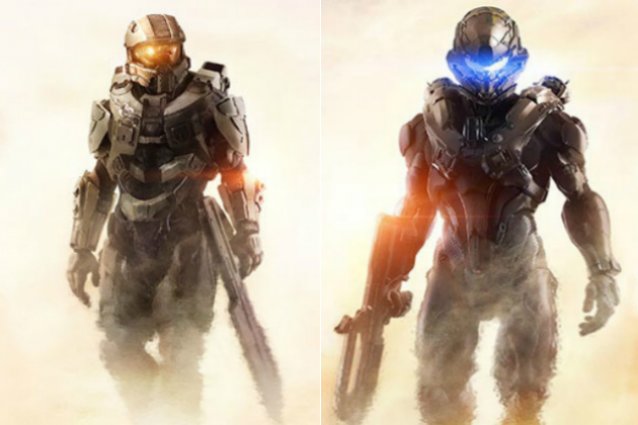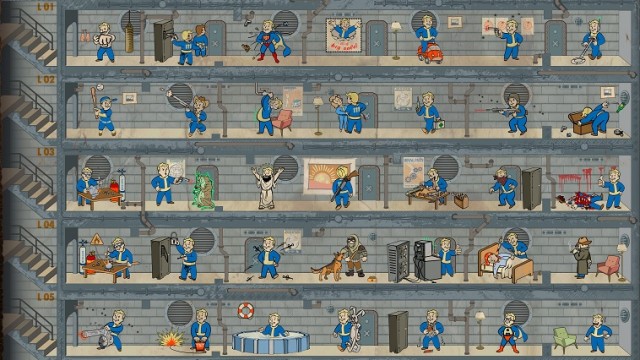

Fallout: New Vegas, the spiritual, if not direct, sequel to the very successful Fallout 3, offers more adventures in the post-nuclear Wasteland. While the developer of Fallout 3, Bethesda Softworks, is publishing New Vegas, ithanded the development responsibilities for this title to Obsidian Entertainment, who is best known for its work on Star Wars: Knights of the Old Republic 2 and the more recent Alpha Protocol. In our review, we’re happy to report that, overall, Obsidian did the Fallout universe proud. Unfortunately, bugs and glitches are a major problem and threaten to overshadow their accomplishment.
Fallout: New Vegas attempts to apply the gameplay mechanics of Fallout 3 to a Western setting, but with better pacing and less dreariness. The game takes place a few years after the events in Fallout 3 and does not involve the main character from that story. Instead, you’ll be playing the role of a courier who is shot for unknown reasons while making a delivery in the Mojave Wasteland. After being rescued from your premature burial by a wannabe cowboy robot named Victor, the main quest will have you initially tracking down your assailant in order to find out why you were attacked and what was so important about the package you were delivering. In doing so, you’ll make your way to the flashing neon and opulence of New Vegas, which was largely undamaged by the nuclear apocalypse, and where additional plot lines will unfold.
Along the way, you’ll run into numerous people who need a helping hand of some kind or who just want a piece of your hide. Various factions populate New Vegas, but two in particular compete for supremacy over the Mojave Wasteland: the New California Republic, which operates in a manner not dissimilar to the United States government, and a slaver organization known as Caesar’s Legion, which dresses up like Roman Legionnaires and crucifies its enemies. Properly dealing with each could mean the difference between life or death.
To say this is an open-world RPG is an understatement. There is an incredible amount of side quests (70!) in which you can engage, and some are even better than the main quest itself. You could easily spend over 100 hours exploring the 200 primary locations in the Wasteland. In completing these quests, you’ll always have a couple of options on how to proceed, whether it be though violence or more peaceful means.
New Vegas is so similar to Fallout 3 when it comes to character build and progression, that it almost feels like a huge expansion pack. Obsidian did add some wrinkles, though. While the Pip-Boy, S.P.E.C.I.A.L., and Perk systems make their return, players can now also select character modifications from the optional Trait list. Present in the Fallout games prior to Fallout 3, each Trait grants a positive and negative bonus to the player.
Additionally, your character’s reputation among the game’s various factions is now actively tracked. Help out the New California Republic? You’ll be given special benefits such as cheaper store prices, combat assistance, or new quest opportunities. Of course, when you assist one faction, you risk angering its enemies. Perform enough activities against a particular faction’s interests, and they’ll attack you on sight. While the reputation system would seemingly allow for a “shade of gray” style of play, allowing you to interact with each faction to further your own goals, the Karma system betrays that idea since killing “evil” faction members grants a Karma increase and vice-versa.
Wearing the armor of particular faction will now allow you to walk around its compound without fear of attack, so long as you don’t run into any high-level NPC’s or guards. But keep in mind that when donning the equipment of a faction, you’ll be treated as a part of that faction by your allies too. Walking into a NCR base while wearing Legionnaire armor will cause you to be greeted with a hail of bullets, regardless of your sparkling reputation with the NCR.
The crafting system has also been expanded as now you can construct weapons, ammunition, and food if you have the required parts and skill level. Modifications to weaponry are also possible. While these additions give players more options, which is a good thing in a RPG, most weaponry and food are so plentiful that only crafting fanatics will feel compelled to regularly use them.
Combat is largely unchanged from Fallout 3, but the learning curve was much easier. Players may recall the Vault-Tec Assisted Targeting System (V.A.T.S.), which pauses the action and allows the player to pick the body part to target. The outcome of your attack is determined by your skill with that particular weapon. The one major difference from Fallout 3 is that players may now use the V.A.T.S. system when performing melee attacks. While it works just fine, ammunition is so abundant that I rarely found the need to use a melee weapon. Obsidian did try to improve the shooting mechanic by adding a gun sight to most weapons, and I felt as though I could target enemies more easily than in Fallout 3. However, my aim often did not seem to matter as I could be shooting right at my target and miss and vice-versa. For RPG fans, this skill-based shooting mechanic may be preferable, but FPS vets are likely to be put off.
I Get By with A Little Help from My Friends
Obsidian made several improvements to the companion system. You can still have one humanoid and one non-humanoid companion accompany you throughout your journeys in the Wasteland but a companion wheel makes interacting with your NPC allies much easier. You still cannot directly control your allies, which can be a problem at times inside buildings, since their pathfinding abilities can separate them from the player. Unless you are playing in Hardcore mode, your companions will only be knocked unconscious if they take too much damage, which is a welcome change from Fallout 3.
On Normal difficulty, with my companions in tow, there were huge sections of the game where I felt overpowered and enemies did not put up much of a challenge. Even the combat early in the game was much less difficult than when you left Megaton for the first time in Fallout 3. Enemy AI was also dodgy at times as enemies occasionally got stuck on objects, making them easy pickings.
New Vegas was built with the same game engine used for Fallout 3, which was not exactly pumping out cutting-edge graphics back in 2008. While some of the scenery at times can look impressive, most of the game appears visually outdated and many of the objects and structures of Fallout 3 have been recycled. Not surprisingly, the PC version looks a lot sharper than the console versions.
Having less than high-quality graphics is not a deal breaker, unless they affect the gameplay negatively in some way. For the most part, the visuals in New Vegas are competent enough to convey the story and gameplay. However, because the GECK engine offers very little when it comes to facial animations and body movement, there is often a disconnect between the words being spoken by NPC’s and the visuals onscreen. Thus, even the best-delivered dialogue comes across as stiff and wooden, which is a shame because the dialogue and voice acting for Fallout: New Vegas show much more personality and variety than its predecessor.
There are lot of technical hiccups along your quest, unfortunately. We were provided a copy of the PC version for review and similar to what has been reported for the Xbox 360 and PS3 versions, I encountered several technical problems in the release version of this game. These were not just minor graphical glitches or a couple of broken quests (although those issues were also present – see below). On release, Fallout: New Vegas was filled with major game-breaking bugs. Getting the game to function without a huge drop in framerate was initially a major challenge. Once I applied an unofficial fix for this problem in order to make the game playable, the Autosave/Quicksave system failed after a crash and I lost about five hours of progress. After the save functionality was restored by an official patch, New Vegas repeatedly froze or crashed, and there was no apparent trigger event that I could avoid. Reviewing this game has certainly been an exercise in patience.
See the Miraculous Gravity-Defying Corpse!
Fortunately, Obsidian and Bethesda have reacted quickly to the numerous issues with New Vegas, and they have released patches for the PC and Xbox 360 versions. A PlayStation 3 patch is planned as well. While the released patches solved the Autosave/Quicksave problem on the PC and some of the scripting errors, I still encountered random crashes and occasional sluggishness, but such occurrences became a lot less frequent.
You’re likely to never find a game more maddeningly frustrating as New Vegas in that it offers an incredibly deep and compelling RPG experience, but in a way that will have you repeatedly banging your head against your controller due to the technical glitches. So should you buy Fallout: New Vegas? The bottom line is that if you were a fan of Fallout 3, you will undoubtedly enjoy New Vegas. While the “expansion pack” criticism is not entirely unfair, the story is different enough that you won’t mind the similarities to Fallout 3. In fact, you’ll probably appreciate that many of the mechanics you loved from the previous game are here. Obsidian and Bethesda Softworks are actively working on patching the title on all platforms, so chances are that most, if not all, of the bugs will be remedied in the near future. If you’re prone to frustration and angry tirades, you may want to hold off until then.
As for those who hated the V.A.T.S.-centric combat system from the original title, this probably isn’t your cup of tea. But if your main gripe about Fallout 3 was the story and you’re a fan of role-playing games, you may want to at least give New Vegas a try as the game offers an RPG adventure that should not be missed.
Fallout: New Vegas is currently available for the PC, PlayStation 3, and Xbox 360.




 5 Ways Halo 5s Story Could Blow Us All Away
5 Ways Halo 5s Story Could Blow Us All Away Dying Light: World 1-1 Easter Egg, and the Pyza Blueprint (Hidden Blueprint)
Dying Light: World 1-1 Easter Egg, and the Pyza Blueprint (Hidden Blueprint) DmC Devil May Cry Guide: How to Master Dante's Weapons
DmC Devil May Cry Guide: How to Master Dante's Weapons Fallout 4: Infinite Special Points Glitch On PS4 and Xbox One Discovered
Fallout 4: Infinite Special Points Glitch On PS4 and Xbox One Discovered Huge Discounts On TVs, Bluetooth Speakers, and Mirrorless Cameras Available Now
Huge Discounts On TVs, Bluetooth Speakers, and Mirrorless Cameras Available Now